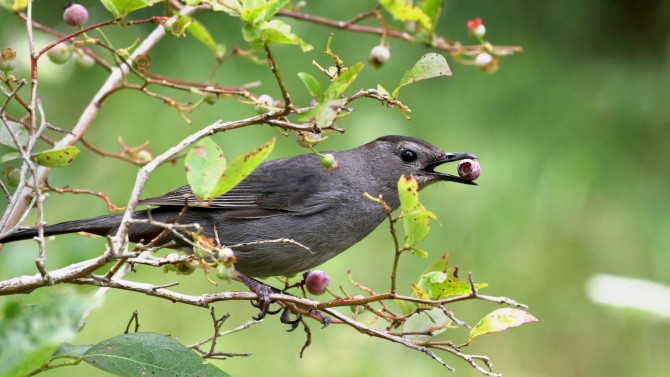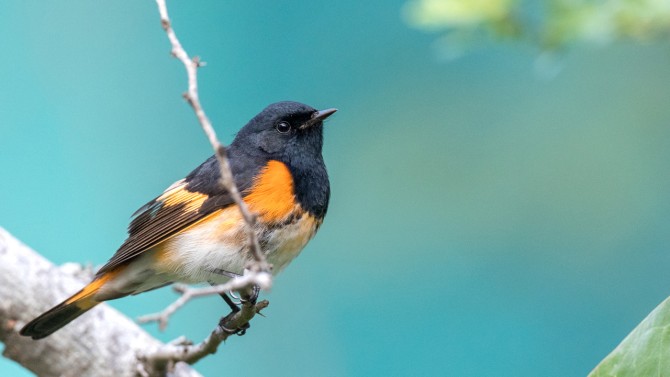An estimated 3,600 species of wild bees serve as pollinators in the U.S., playing a crucial role for the nation's agriculture. But those bee populations appear to be in decline, and with scant data on wild bees, conservation efforts have proven difficult.
A new publicly available tool, developed by the Cornell Lab of Ornithology and the Cornell Atkinson Center for Sustainability, can track and estimate the diversity of wild bees using one of Cornell's greatest areas of expertise: birds.
The fruit-eating gray catbird can indicate the presence of flowering shrubs and trees that attract certain species of bees.
"Birds can be powerful bioindicators, and they can provide a really useful lens to better understand what's happening with bee declines," said Amanda Rodewald, Garvin Professor and senior director of the Center for Avian Population Studies at the Cornell Lab of Ornithology. "To be clear - we absolutely need more and better direct, on-the-ground data on bees, but that takes time. We know decisions must be made now to conserve bee populations - if we don't, we'll lose the battle. By leveraging the rich information we have on birds, this tool might be able to fill a gap in the short-term."
In a study underpinning the Wild Bee Diversity Prediction Tool, published April 23 in PLOS One, researchers found that integrating data from the Cornell Lab of Ornithology's eBird program, a global participatory science project, with satellite information about land cover from the U.S. Department of Agriculture, along with previous surveys of wild bees, better predicted wild bee diversity across the eastern and central U.S. than satellite imagery alone.
"Bees and birds respond similarly to some of the same agricultural practices that are being used, some of the same habitat attributes, or even what's happening in the overall landscape," said Rodewald, senior author, professor of natural resources and environment in the College of Agriculture and Life Sciences (CALS), and a faculty director at Cornell Atkinson. "They can tell us things that may not be visible from satellite imagery."
The researchers, including first author and former postdoctoral researcher Josée Rousseau and co-author Alison Johnston, former research associate, gave the example of the fruit-eating gray catbird, which can indicate the presence of flowering shrubs and trees. The presence or abundance of open woodland species like chipping sparrows, or species that seek out the understory of forests, like American redstarts or wood thrushes, can give more granular data about large swaths of woodlands that are undifferentiated in satellite imagery.
The authors also pointed to overlaps between bees and birds in nesting and foraging behaviors, as well as their shared sensitivity to multiple conditions when choosing habitats.
The tool is available for anyone to use but will be particularly useful for conservation groups, the researchers said. It has already pointed to agricultural regions in the Midwest that still harbor diverse bee communities and, with conservation, could become strongholds for wild bees in areas where monocrops of corn and alfalfa otherwise dominate.
"This tool is pointing to some areas that are really important for bees, where conditions seem to be deteriorating," Rodewald said. "With that information, conservation groups can now get out there on the ground to better figure out what's happening. This helps us focus on where to look."
Moving the dial
The impetus for the tool came in response to a need in industry: the Walmart Foundation, in talks with Patrick Beary, the Bruce H. Bailey Senior Director of Strategic Partnerships for Cornell Atkinson, expressed concern about declining pollinators and how it could impact the resilience and productivity of the food system.
"Everyone involved wants to help pollinators, but effective action requires better information," Beary said. "Companies, governments, local communities, farmers and conservation groups want assurance that their investments in pollinator habitat protection and restoration will maximize impact."
Beary brought the problem to Rodewald, who was already interested in using birds as an indicator of other environmental conditions. After initial explorations, they secured funding from Walmart Foundation to pursue the tool.
American redstarts seek out the understory of forests - their presence adds more detail to satellite imagery of otherwise undifferentiated woodlands.
Continued conversations with Walmart Foundation and numerous conservation organizations were essential to understanding how the tool could make the most impact, Beary said.
"The collaborative process yielded tremendous response - there's substantial demand for this information," he said. "There's already been a lot of action and commitments and investment, but organizations have had to do that with very little information, so people welcome a tool and a methodology and collaborations that can give more insight and legibility."
"We really wanted to move the dial on improving sustainability, advancing conservation," Rodewald said. "That meant we were engaging with the potential users and stakeholders right from the start to understand their goals, needs, and the major challenges and constraints they're facing."
The team hopes to integrate data from the tool with another effort, FoodS^3, out of the University of Minnesota and the Nature Conservancy, that tracks the impacts of climate change on supply chains. They also hope the tool can help assess past conservation efforts.
Gail Phillips, project manager for strategic partnerships at Cornell Atkinson, is eager to expand the project's reach. "We're looking for partners ready to put this tool to work," Phillips said. "We want to hear from groups with ideas for collaboration or adaptation for their own needs."
Rodewald said the project embodies a core tenet in the missions of the Cornell Lab of Ornithology, Cornell Atkinson, CALS and the university as a whole.
"At all levels of the university, there is just a genuine desire to make a difference and be a positive impact in the world," she said. "At the highest level, that's what we're doing."
"At Atkinson, we see our jobs as building stronger bridges between potential users of our research or expertise and the research ecosystem here - and it's a powerful combination," Beary said. "This project exemplifies that approach."








